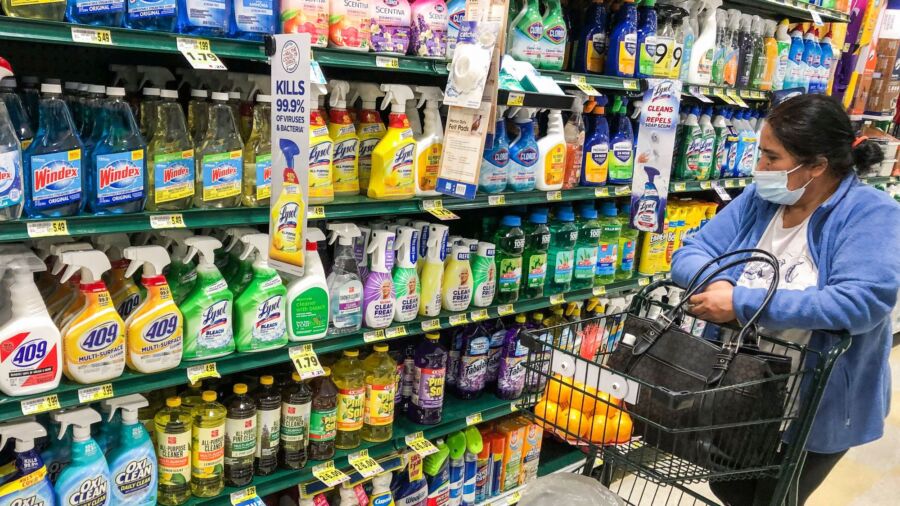Researchers from the United States have found that many household cleaning products, including those marketed as supposedly eco-friendly and “green,” could be harmful to humans.
A peer-reviewed study, titled “Volatile organic compounds emitted by conventional and ‘green’ cleaning products in the U.S. market,” was published in the journal Chemosphere on Sept. 13.
As part of their study, researchers from the non-profit Environmental Working Group (EWG) analyzed 28 cleaning products and two air fresheners for hazardous human-made chemicals known as volatile organic compounds (VOCs), checking the air quality impacts of the products and measuring the number, concentrations, and emission factors of VOCs.
This was done through the use of an air chamber following product application, researchers said.
The cleaning products used in the study were not specifically identified but consisted of various cleaners, including all-purpose, carpet, floor, glass, and wood cleaners as well as laundry stain removers, according to researchers. All of the items were purchased from online retailers between December 2019 and May 2022.
In total, 14 of the products were standard, conventional, household cleaning products while nine were fragranced “green” items. Another seven were fragrance-free cleaning products marketed as “green.”
“Exposure to cleaning products has been associated with harm to the respiratory system, neurotoxicity, harm to the reproductive system, and elevated risk of cancer, with greatest adverse impacts for workers exposed in an occupational setting,” researchers wrote.
“Social and consumer interest in cleaning products that are safer for health created a market category of ‘green’ products defined here as products advertised as healthier, non-toxic, or free from harmful chemicals as well as products with a third-party certification for safety or environmental features,” they said.
Health Effects of VOCs
Overall, researchers detected 530 unique VOCs in all 30 of the products, including eco-friendly “green” products with and without fragrances, they said.
Of the 530 VOCs, 193 were considered health hazards based on either California’s Department of Toxic Substances Control Candidate Chemicals List or the European Chemical Agency’s Classification and Labeling Inventory, researchers said.
According to the U.S. Environmental Protection Agency (EPA), VOCs have a high vapor pressure and low water solubility and are used and produced in the manufacturing of paints, pharmaceuticals, and refrigerants. They are also often components of petroleum fuels, hydraulic fluids, paint thinners, and dry cleaning agents.
They are emitted as gases from certain solids or liquids, such as everyday household cleaning products.
“VOCs include a variety of chemicals, some of which may have short- and long-term adverse health effects,” the EPA states. “Concentrations of many VOCs are consistently higher indoors (up to ten times higher) than outdoors.”
Those short- and long-term health impacts may include everything from headaches, loss of coordination, and nausea to liver, kidney, and central nervous system damage, according to the EPA.
Some organics can cause cancer in animals while some are suspected or known to cause cancer in humans, the EPA notes.
According to their study, researchers with EWG found that “green” products still emitted VOCs but at a lower level than their non-green counterparts.
“Greater total concentration, total emission factors, and numbers of VOCs were generally observed in conventional cleaning products compared to products identified as ‘green’, particularly compared to fragrance-free products,” researchers wrote.
‘Wake-up Call for Consumers’
“A hazard index approach was utilized to assess relative risk from measured VOC emissions. The five products with the highest hazard indices were conventional products with emissions of 2-butoxyethanol, isopropanol, toluene, and chloroform,” they continued.
“Overall, this analysis suggests that the use of ‘green’ cleaning products, especially fragrance-free products, may reduce exposure to VOC emissions,” researchers concluded.
Researchers said the findings suggest using so-called “green” cleaning products may actually be safer.
“This study is a wake-up call for consumers, researchers, and regulators to be more aware of the potential risks associated with the numerous chemicals entering our indoor air,” said Alexis Temkin, a senior toxicologist at EWG, in a press release.
“Our findings emphasize a way to reduce exposure to hazardous VOCs — by selecting products that are ‘green,’ especially those that are ‘green’ and ‘fragrance-free’” she said.
The American Cleaning Institute (ACI), which represents producers of household and industrial cleaning products, told CBS News that manufacturers have been working to reduce VOCs in products.
“The fact is, in California … regulators have placed limitations on the VOCs in most consumer products over the past three decades,” the ACI said. “Industry has been working with government and regulators for decades to minimize VOC concentrations to keep them below levels that would be considered hazardous,” it added.
However, the trade group also criticized the researchers in the study for the criteria they used judging products as “conventional” or “green.”
“Green is a marketing term, not a scientific one,” the group said. “The proper use of cleaning products contributes to public health and quality of life in homes, offices, schools, health care facilities, restaurants, and throughout our communities every single day. Everyone who has dealt with the coronavirus pandemic can certainly recognize this fact.”
From The Epoch Times


